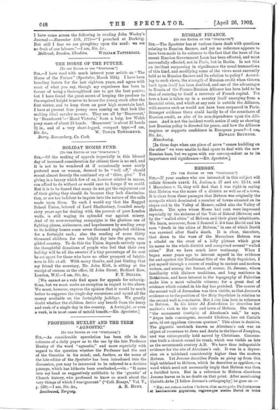HEBRON.
[To THE EDITOR OF THE "SPECTATOR."] Sin,—If your readers who are interested in this subject will collate Genesis xxxvii. 14, Joshua x. 37 and xiv. 12-14, and 1 Maccabees v. 75, they will find that I was right in saying that Hebron was the name of a district as well as of a town. It is clear from these passages that Hebron was originally the acropolis which dominated a number of towns situated on its slopes and in the Valley of Mamre, called also the Valley of Hebron. The spies whom Moses had sent were impressed especially by the richness of the Vale of Eshcol (Hebron) and by the "walled cities" of Hebron and their giant inhabitants. We learn, moreover, from 2 Samuel ii. 3-4 that David and his men "dwelt in the cities of Hebron," in one of which David was crowned after Saurs death. It is clear, therefore, that down to the wars of the Maccabees Hebron was a citadel on the crest of a hilly plateau which gave its name to the whole district and comprised several" walled cities." But we have much later testimony. When I began some years ago to interest myself in the evidence for and against the Traditional Site of the Holy Sepulchre, I put myself through a course of reading in ancient and modern writers, and among the former, of course, St. Jerome, whose familiarity with Hebrew traditions, and long residence in Bethlehem, and keen interest in the topography of Palestine make him a most valuable witness ; for a great deal of evidence which existed in his day has perished. The course of the second wall of Jerusalem was then visible, so that Jerome's evidence as to the position of the Holy Sepulchre in relation to the second wall is conclusive. But I cite him here in reference to Hebron. In his letter Ad Eustochium he describes her mother's visit to the vale and town of Hebron. She visited "the monument (vestigia) of Abraham's oak," he says. " Atque inde consurgens, ascendit Chebron, bmc eat Cariath arbe, id eat oppidum virorum quatuor." This alone is decisive. The gigantic terebinth known as Abraham's oak was an object of reverence to Jews and Arabs in the time of Joseplms, and was snbsequently held sacred by Christians. Censtan- tine built a church round its trunk, which was visible as late as the seventeenth century A.D. We have thus indisputable evidence for the site of Abraham's oak. It was in a depres- sion on a tableland considerably higher than the modern Hebron. Yet Jerome describes Paula as going up from this high tableland to Hebron, which he describes as oppidum,—a word which need not necessarily imply that Hebron was then a fortified town. But in a reference to Hebron elsewhere Jerome leaves us in no doubt on that point. After mentioning Cariath-Arbe [I follow Jerome's orthography] be goes on :— " HEBC eat autem eadera Chebron ohm metropolis Philistinorum at habitaculum gigantum, regannalus motet' David in WW1
Jude civitas sacerdotalis et fugitivorum. Distat ad meridianam plagam ab Elm [i.e., Jerusalem] =Wham oirciter viginti-duobus quercus Abraham, qute et Mame, ufsque ad Constantini reefs imperium monstrabatur : et Mausoleum ejus in prassentiarum Uprfesentarium] oernitur. Cumque a nobia jam ibidem ecclesia rdificata sit, 1 cunctis in circuitu gentibus terebinthus super- stitiose colitur eo quod sub ea angeloa Abraham quondam hospitio susceperat Theo ergo primum Arbee, poste& Chebron uno filiorum Chaleb sortita vocabulum est."
After passing references to other places in Palestine, Jerome says "Est et alind castellum Thamara pergentibus Eliam
de Chebron, ubi muse Romanum prcesidiuns position est."—(Do Locis itsbraicis, Jerome's works, edited by Erasmus, Tom. III., p. 270.)
In the time of Jerome, therefore, Hebron was a fortified town on the crest of a hill, and was occupied by a Roman garrison.
I think my friend Dr. Llewelyn Davies will now see that Browning describes with strict accuracy the picture presented to David's eyes as he looked from Bethlehem towards Hebron while the dawn was "struggling with night on his shoulder."
Hermon does not answer the description at all. Like "J. D.," I once, but only once, caught a glimpse of the snowy summit of Hermon from the valley of the Jordan. But that is only possible on a very clear day. I never saw Hermon from Beth- lehem or its neighbourhood, though that is much higher than the neighbourhood of Jericho. But neither from the Jordan Valley nor from Bethlehem is the " shoulder " of Hermon visible. Can any of your learned readers give an approximate estimate of the longevity of the terebinth of Syria, either absolutely, or relatively to our own oak P There is a gigantic terebinth now at Hebron which is pointed out to travellers as Abraham's oak. Of course it is not the tree mentioned by Josephus and Jerome, but its age must be very great. I wonder if there is any record of a modern expert having computed its age.—I am, Sir, &e., 31A.Lcorai MacCoLL. The Residence, _Ripon.
[We must close this controversy with Canon MacColl's learned and interesting letter; but we shall, of course, be glad
to publish any short answers to the question of the longevity of the terebinth.—En. Spectator.]



























































 Previous page
Previous page